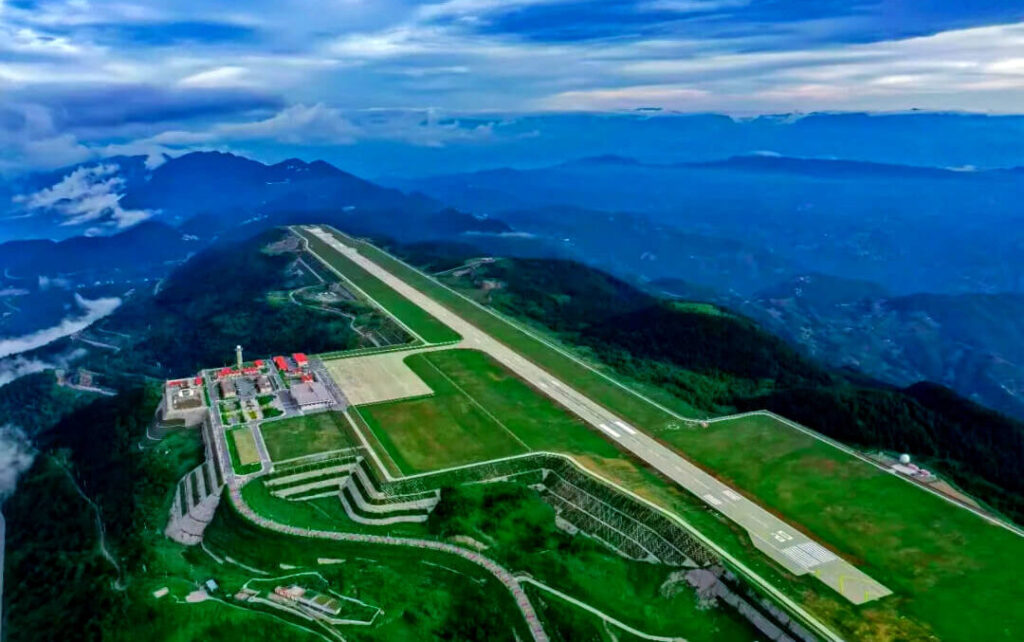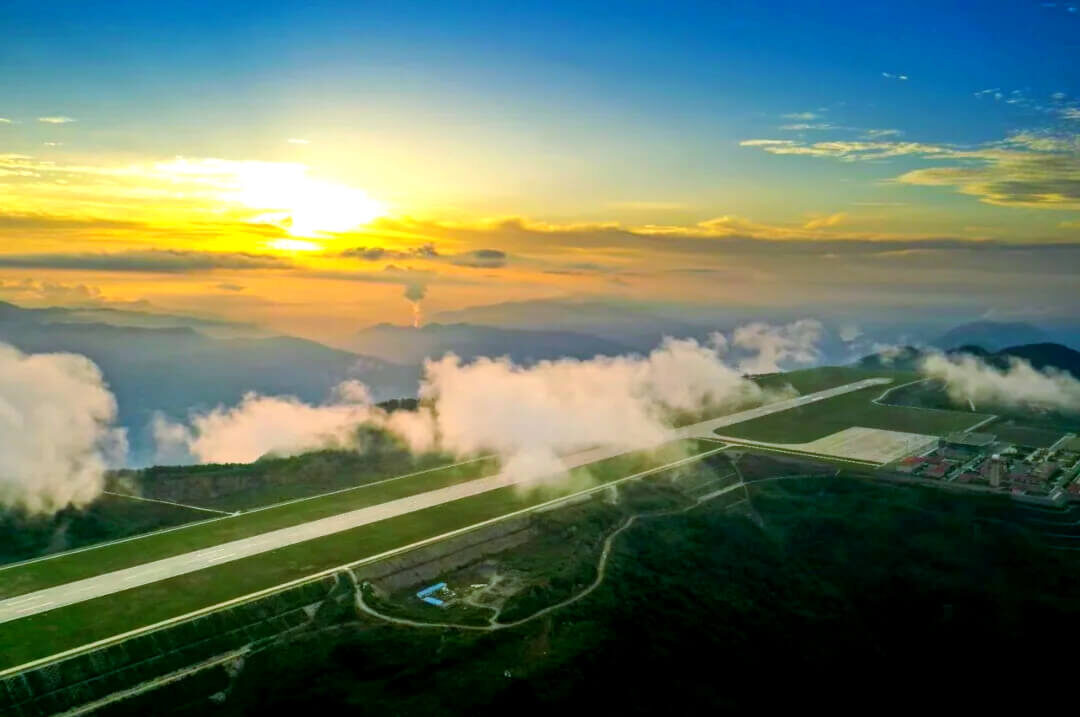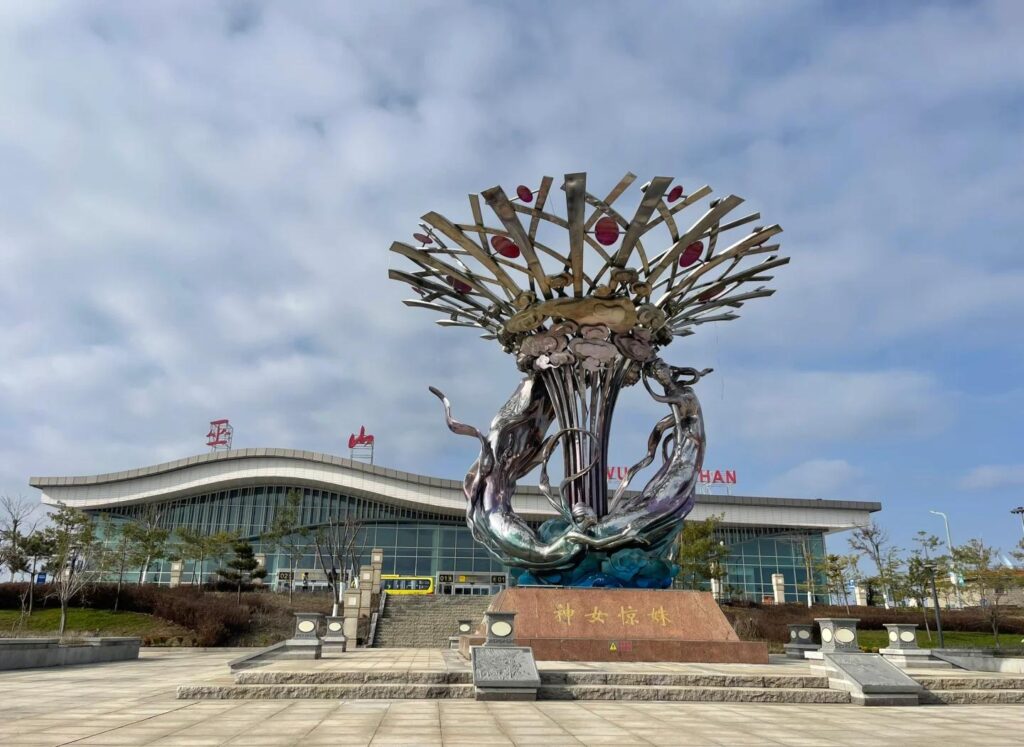Ever heard of Wushan Airport? Probably not—unless you’re into airports built at 1,771 meters above sea level, with no metro, unpredictable clouds, and a rooftop that mimics the curves of the Yangtze River. Tucked into the cliffs of Chongqing’s Three Gorges, Wushan Airport (WSK) isn’t just scenic—it’s engineered to survive freezing fog, 10cm of ice, and mountain winds that would ground planes elsewhere.This place skips the fancy lounges and gives you something better: a landing that feels like flying into a landscape scroll. Its curved roof, made of aluminum-magnesium panels over foam glass and waterproof membranes, looks more like art than infrastructure. Whether you’re chasing red leaves, cruising the river, or just want bragging rights—Wushan Airport is where the real trip begins!

The scenic views from Wushan Airport
What Makes Wushan Airport So Special?
Perched at 1,771 meters above sea level, Wushan Airport (IATA: WSK) isn’t just the highest civil airport in Chongqing—on some days, it literally floats above the clouds. Locals like to call it “the airport in the sky,” and honestly, when you see the mist roll in over the peaks, it’s hard to argue with them. The airport sits deep in northeastern Chongqing, in a region better known for gorge cruises than takeoffs and landings.
But the altitude alone doesn’t tell the whole story. The airport’s roofline curves—they weren’t thrown in for looks. They mirror the flow of the Yangtze River, and the silhouette of Goddess Peak, a mountain locals associate with Wushan mythology. Instead of a flat industrial shell, the designers went with a folded H65/400 aluminum-magnesium-manganese panel system, layered over foam glass insulation and an SBS-modified waterproof membrane. No support beams underneath—just clean geometry and a whole lot of planning. It even looks architectural from a Google Earth zoom-in.
So why the technical drama? Because winter here hits hard. Ice builds up—sometimes over 10 centimeters thick. Winds lash across the tarmac, and temperatures have dropped to -14°C in past years. That’s why the design team used Rhino software to simulate how snow and water would drain across every slope and seam. Maybe it feels like over-engineering—but after five winters, no leaks, no major delays. In a place where even the rivers freeze, that’s saying something.
Here is some basic information about Wushan Airport:
- Full Name:Chongqing Wushan Airport
- Address:Wushan County, Chongqing Municipality, China
- Airport Code: IATA: WSK ICAO: ZUWS
- Country Code:+86 (China)
- Terminals:1
- GMT:GMT +8 (China Standard Time)
Wushan Airport Has Multiple Access Routes

The runway at Wushan Airport
There’s No Metro, but Flights, Trains, and Ferries Work
Wushan Airport doesn’t connect to any metro line—there’s no light rail station, no airport express, not even a shuttle platform with a metro logo. You won’t spot signs saying “出口 to subway,” and if you’re used to flying into big cities, this might catch you off guard. Still, it’s not unmanageable—just layered, in that very western-China kind of way.
The fastest method, honestly, is to fly from Chongqing Jiangbei International Airport. Direct flights usually take a little over an hour, but here’s the thing: there are only a few per day, and they sell out quickly—especially during holidays or foggy seasons. Another route? Take the high-speed rail to Fengjie or Wanzhou North, then transfer to a long-distance bus or hire a car to climb the winding hills—expect at least three hours on the road, if not more. It's scenic, sure. But casual? Not quite.
Then there’s the quirky route some travelers swear by—coming from Yichang. You might find people who take a Yangtze cruise or sleeper bus downriver to Wushan Port, then switch to a cab to reach the airport. Apps like Gaode Map or Ctrip definitely help, but don’t wing it—after dark, your ride options shrink fast. This isn’t Shanghai. It’s deep mountain China. And here, you travel on the landscape’s terms—not yours.
Local Transfers Are Available After Landing
Let’s be real—Wushan Airport isn’t exactly hooked up to a national transportation matrix. No Maglev, no subway, not even a major shuttle bus line. But landing here doesn’t leave you stranded. Taxis, private transfers, even the odd minibus show up—but you'll likely need to pre-arrange or ask staff for help.
If your next stop is one of the Yangtze River hotspots—say Shennv Stream, Baidicheng, or the red-leaf canyons in late fall—then you're looking at fares starting around ¥80, depending on where you’re going and whether you book through DiDi or flag a local cab (pro tip: set DiDi to English before you land). The roads are steep, curvy, and once you leave the airport, don't expect much English on the signs.
Can you get to Chongqing city center from here? Technically, yes. Practically? That’s a rough 7-hour combo of mountain roads, train transfers, and maybe a headache. Unless you absolutely need to get back, flying or arranging a pickup is way smarter. Most travelers stick to the Three Gorges region, which—let’s be honest—is kind of the whole reason this airport was built.
Wushan Airport Connects to Key Chinese Cities

Wushan Airport, known as the “aircraft carrier in the clouds”
Domestic Flights You Can Take in 2025
Despite being tucked into the mountains, Wushan Airport (WSK) isn’t cut off from the rest of China. Several domestic routes now connect it to key cities—like Chongqing, Xi’an, Wuhan, and occasionally Guangzhou. These aren’t huge jets—it’s usually regional flights, mostly operated by China Express Airlines (华夏航空). Seats fill fast, especially around October when the red leaves roll in, so last-minute tickets? Not a good idea.
Most flights land in the morning or just before sunset. That’s partially due to fog risk in the gorges—pilots need those clear windows. If you’re flying in, double-check your airport code says WSK, not YIH or LYK. The names sound close on booking platforms, and more than one traveler has ended up in the wrong corner of Hubei by mistake. That’s a mood killer you don’t want.
What’s cool is that this airport makes three-gorge trips doable for short-term visitors. You can arrive from a major city in under 2 hours, hop on a local tour, and still make it back in time for dinner. If you book smart, the whole thing’s smoother than you'd expect for such a remote spot.
Foreign Visitors Can Use the Airport Smoothly
For a regional airport tucked deep in the gorges, Wushan Airport is surprisingly easy to manage—if you walk in with the right expectations. Don’t expect luxury lounges or perfectly bilingual announcements. But if you’ve traveled in western China before, you’ll know: this place is actually pretty decent.
Most signs are in Chinese, but key ones—like “Security Check”, “Boarding Gate”, or “Exit”—are paired with English translations. That said, the staff are usually kind. They might not speak fluent English, but if you hold up your boarding pass and smile, they’ll point you the right way.
Payment-wise? You’ll want Alipay or WeChat Pay on your phone. Both now support foreign credit/debit cards, and I’ve seen travelers use YouTrip, Revolut, even Mastercard via QR code. Cash still works too, but you might get a confused look if you pull out a foreign bill. And yeah, you can buy snacks or water after security—just don’t expect Starbucks. It’s more like local milk tea and instant noodles (but hey, sometimes that hits the spot).
If this is your first time flying through a small Chinese airport, Wushan won’t stress you out. The scale is human, the people are helpful enough, and you won’t be sprinting between terminals. Honestly, compared to bigger hubs where you can get totally lost, this little airport almost feels... comforting.
Useful Travel Info for First-Timers
Here’s the thing about Wushan Airport: it’s small, remote, and practical—but you’ll want to come prepared. For starters, there’s no hotel inside the terminal. If your flight gets delayed or you arrive late, don’t expect capsule beds or overnight lounges. The nearest reliable hotels are either down in Wushan town or along the riverside tourist zones. Some places show up on Trip.com, but not all accept foreign passports—double-check before booking.
That said, a few hotels around Goddess Plaza and Shennüxi Visitor Center do cater to international tourists, especially during peak season. Prices vary, but you’re looking at ¥300–¥600 per night for something clean and foreigner-friendly. Try to get one that offers airport pickup—some do, but only if you message them in advance (and yes, a screenshot in Chinese helps).
Now let’s talk flights. Booking through Trip.com, Ctrip, or the airlines’ official apps is your safest bet. Just make sure your airport code says WSK, not “Sanxia Airport” or “Three Gorges Airport,” which sometimes show up in third-party apps but refer to entirely different places like Yichang or Lichuan. Also? Don’t assume same-day return flights exist—they often don’t. Wushan is still developing its routes, and flights sell out quicker than you’d think.
So, bring patience, a downloaded translation app, and maybe some snacks. It’s not a stressful place—just not built for travelers who expect everything to be plug-and-play.
The View from Wushan Airport Is Worth the Flight
Not every airport gives you a front-row seat to a UNESCO-level landscape, but Wushan Airport does—without even trying. As soon as you step off the plane (especially if you're lucky enough to land early), there’s a good chance you’ll spot the Goddess Peak (神女峰) rising from the mist, or catch a slice of Qutang Gorge’s cliff walls glowing orange under the morning sun. Some travelers say it feels like landing on top of a scroll painting—and they’re not exaggerating.
Outside the terminal, there are a few platforms where locals and staff sometimes stop just to look. They're not labeled as “official viewpoints,” but if you walk toward the southern edge of the parking lot, you’ll find spots where the whole river bend and valley open up beneath you. If you’re into photography, this place rewards early risers—around 6:30 a.m., when the fog is thick and golden, the mood is something else. Don’t follow the crowd; the best moments are usually when you're alone.
Now, a bit of planning helps. The best time to fly into Wushan is mid-October through early December, when the red leaves hit their peak and the cloud sea starts rolling over the gorges. Avoid the rainy season if you can—summer thunderstorms often delay flights, and winter fog can cancel them entirely. Local forecast apps like 彩云天气 or 墨迹天气 are surprisingly accurate for this region.
Sure, most people fly here for the access to the Three Gorges, but even if your plan is just a quick connection, this view alone makes the detour worth it.
Frequently Asked Questions (FAQs)
Q: Can I use VPN or foreign SIM cards at Wushan Airport?
Wushan Airport is small and located in a mountainous area, so don’t expect super strong mobile signal everywhere. If you're using an international SIM card with roaming, it might work, but speeds could drop unexpectedly—especially near the gates or parking lots. Public Wi-Fi is sometimes available, but rarely consistent or open. As for VPNs, technically you can use them if your app is already installed before entering China. But some networks here throttle VPN traffic or block certain services altogether. If you're counting on a VPN to access email or Google Maps, it’s safer to set up offline downloads ahead of time or use Chinese alternatives like Baidu Maps (with English mode).
Q: Are drones or professional cameras allowed around Wushan Airport?
Good question—and one many travelers forget to ask until too late. Wushan Airport is close to scenic but sensitive areas like the Three Gorges and some military zones. Technically, drone flying near civil airports is strictly regulated in China. You need a drone license and local approval—especially near high terrain. Even for DSLR shooting from public platforms, security may ask questions if your gear looks “too professional.” It’s safest to take photos from the viewing spots outside the terminal with handheld gear and avoid flying anything unless you’ve cleared it officially.
Q: What’s the emergency medical service like at Wushan Airport?
Wushan Airport has a small medical station for minor emergencies—think altitude dizziness, cuts, or fevers. But anything serious? You’ll need to be taken down to Wushan County People’s Hospital, which can be 30–40 minutes by car depending on road conditions. If you have chronic illness or need regular medication, carry everything with you and don’t assume there’s a 24-hour pharmacy nearby. The airport staff will call emergency services if needed, but communication may be slow if you don’t speak Mandarin.


